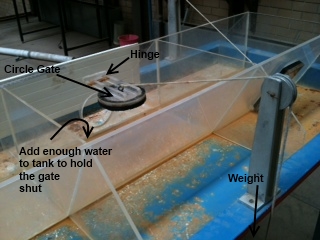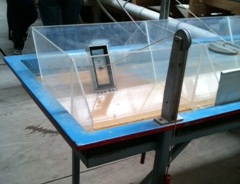Practical 1.1 - Hydrostatics
Apparatus
In this experiment, you will see several tanks, each with a hinged gate on the side. The gates are connected to a known weight by a string (W1, W2 or W3), which applies a point force to the gate (and therefore a moment about the hinge) in such an arrangement that it either holds the gate shut or pulls it open. In each case, an opposing force is created by filling the tank with water. Depending on the arrangement of the gate, the hydrostatic force either forces the gate to open, or keeps it closed.
The hydrostatic pressure will be determined by measuring, with a ruler, the “critical water depth” at which the hydrostatic force creates a moment about the hinge that is in balance with the weight.
Two more tanks in this experiment are shown below. In these tanks the weight holds the gate closed and then water is added to the tank to the point where the gates open.
The top tank has a rectangle door that will be opened when the hydrostatic force in the tank is greater than the weight.
The lower tank has a triangle door that will be opened when the hydrostatic force in the tank is greater than the weight.


